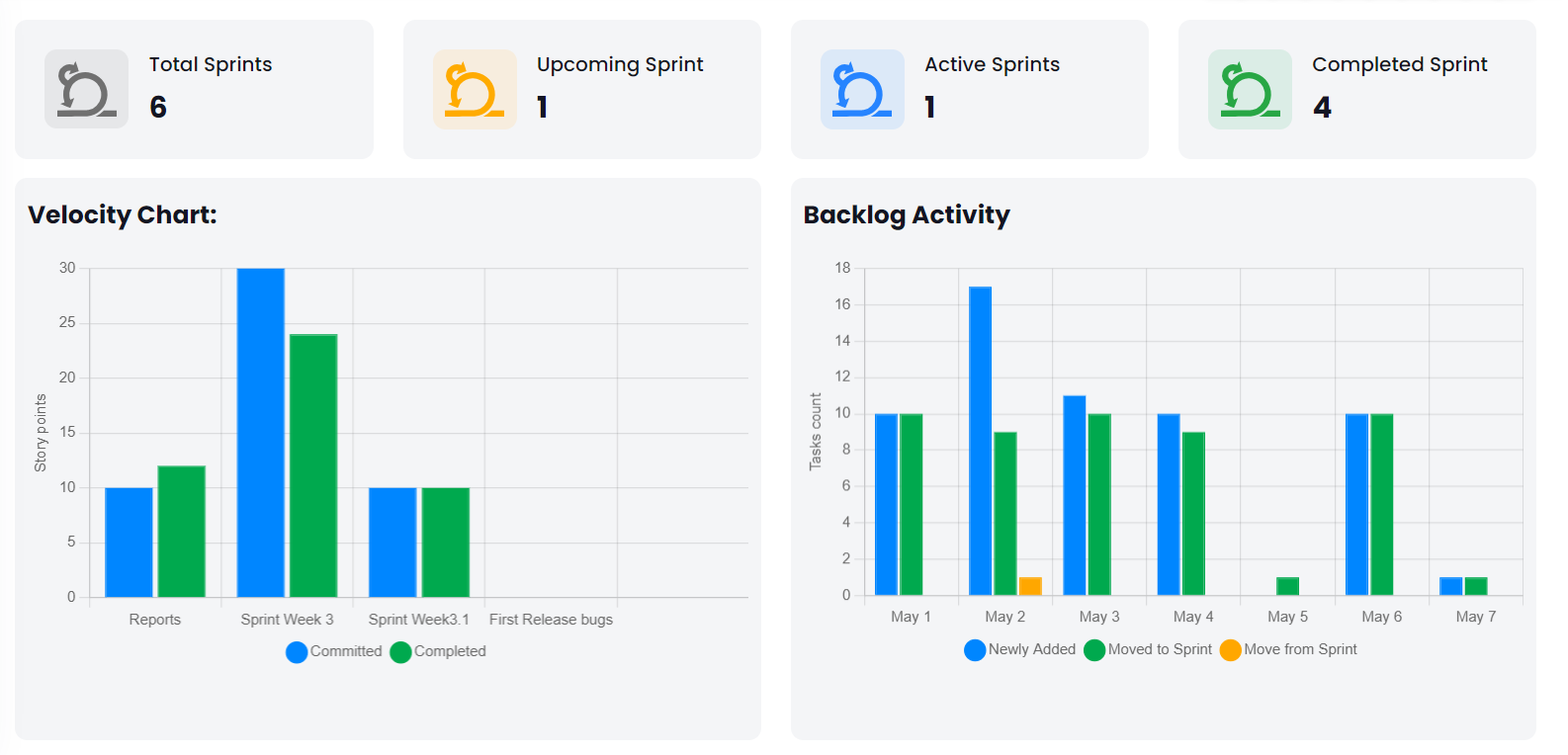Home / Our Blog / Scrum Metrics: A Complete Guide to Measuring Agile Success with Scrum Slate
Scrum Metrics: A Complete Guide to Measuring Agile Success with Scrum Slate
Aug 05, 2025 Agile Methdology
In today’s fast-paced work environments, teams need to move quickly while still staying organized and efficient. That’s where agile frameworks like scrum come in. Scrum allows teams to break down complex tasks into smaller, manageable chunks. But just using scrum isn’t enough. To truly improve, teams need to measure how they’re doing — and that’s where scrum metrics become powerful.
Scrum metrics are key numbers or data points that help teams understand how well they’re working. These metrics show where things are going smoothly and where there’s room to grow. Whether you’re a new team just starting with agile or an experienced one looking to improve delivery, tracking the right scrum metrics can make all the difference. Let’s dive into what they are, why they matter, and how you can use them effectively — especially with tools like Scrum Slate.
What Are Scrum Metrics?
Scrum metrics are clear, trackable numbers that give insight into how a scrum team performs. These might include how much work gets done in a sprint, how consistent the team is, or how long it takes to finish tasks. With the help of these metrics, teams can plan better, find blockers early, and improve collaboration.
They don’t just help during planning or reviews — scrum metrics are useful throughout the development process. When used properly, they can guide decisions, show trends, and support a team’s continuous improvement. The best part? Teams can choose which metrics to track based on what’s important to them.
What is Scrum?
Scrum is a popular agile framework that helps teams tackle complex problems by working in short timeframes called sprints. Each sprint usually lasts 1–4 weeks, where the team focuses on completing a specific set of work.
Scrum isn’t just for software teams anymore. Today, it’s widely used by design, marketing, support, and operations teams. Because of this wide adoption, it’s important to use scrum metrics to measure how well your team is doing—no matter what type of work you handle.
Why Are Scrum Metrics Important?
Scrum metrics allow teams to:
- Make smarter decisions with real data
- Spot issues before they become problems
- Track progress and improve delivery time
- Keep team members aligned and engaged
- Set achievable goals and measure success
Metrics can also show patterns over time, helping teams identify what’s working and what needs attention. Instead of guessing, teams can act on facts — which leads to better results.
Key Scrum Events & Useful Metrics
Scrum includes several recurring meetings, also known as scrum events. Each of these offers a chance to track important data and improve teamwork.
Sprint Planning Metrics
Sprint planning is the meeting that sets the stage for the upcoming sprint. During this session, the team decides what to deliver, how much work to commit to, and what the overall sprint goal should be. Choosing the right metrics at this stage can help ensure the team sets realistic goals and manages workload effectively.
Sprint Goals
Sprint goals define what the team aims to achieve during a sprint. These goals are typically high-level outcomes that tie individual tasks to a broader purpose. Instead of simply listing features or user stories, sprint goals describe the value that the team wants to deliver. Having clear, well-defined goals helps guide daily decisions throughout the sprint. They also create a shared sense of direction and help the team focus on what matters most. In Scrum Slate, sprint goals can be defined during planning and tracked visually throughout the sprint to ensure they stay top of mind.
Team Velocity
Velocity is one of the most fundamental metrics in Scrum. It measures the amount of work a team completes during a sprint, usually in story points or time estimates. Over several sprints, a team’s velocity starts to stabilize, offering a reliable way to predict future sprint capacity. This helps teams avoid overcommitting and improves their ability to forecast timelines and delivery dates. By reviewing historical velocity data in Scrum Slate, teams can plan upcoming sprints with more confidence, basing their decisions on actual performance rather than guesswork.
Capacity Planning
While velocity tells you how much work your team has completed in the past, capacity shows how much work your team can realistically take on in the current sprint. It accounts for factors such as vacations, part-time contributors, and external responsibilities. This is important because a high-velocity team might still underdeliver if half the team is unavailable. With Scrum Slate, team members can input their individual availability, giving a real-time view of the team’s total working capacity. This helps create achievable sprint plans that account for both past performance and current availability.
Work Type Distribution
During planning, it’s also useful to look at the mix of work types in the backlog — including features, bugs, technical debt, and research tasks. Understanding how the team’s effort is distributed helps balance short-term customer value with long-term product health. For example, if most of the sprint is filled with bug fixes, the team might need to re-evaluate its quality practices. Scrum Slate makes it easy to categorize and track these work types so that planning remains intentional, not reactive.
Daily Scrum (Stand-Up) Metrics
The daily Scrum is a short, time-boxed meeting held every day during the sprint. It’s a moment for the team to check in, align, and make quick adjustments. Though it only lasts 15 minutes, the metrics reviewed here can provide valuable insights into sprint health and team collaboration.
Progress Toward Sprint Goals
Each day, team members should reflect not only on their individual tasks but also on how their progress contributes to the overall sprint goals. It’s easy to get caught up in the to-do list and lose sight of the bigger objective. Revisiting sprint goals during daily stand-ups keeps the team aligned and focused. If the team is falling behind, discussing it early allows time to regroup and make necessary changes. In Scrum Slate, current sprint goals and progress can be viewed directly on the sprint board, making it easier for everyone to stay aligned during the stand-up.
Sprint Burndown Chart
The sprint burndown chart is one of the most visual and impactful Scrum metrics. It shows how much work remains in the sprint compared to the number of days left. A healthy burndown chart will show a steady decline, indicating that tasks are being completed consistently. However, if the chart is flat for too long or drops steeply at the end, it might suggest issues like poor estimates or late progress. In Scrum Slate, burndown charts update automatically and help teams quickly spot trends, scope creep, or bottlenecks before they escalate.
Workload Distribution
Understanding how work is spread across the team is crucial in a collaborative environment. During daily stand-ups, reviewing workload distribution helps ensure that no one is overloaded or underutilized. This is especially important in remote or hybrid teams, where visibility into each other’s workload isn’t always obvious. Scrum Slate offers visual workload indicators that show how many tasks each team member is handling. This encourages open discussions, supports fair task sharing, and promotes a healthier, more balanced work culture.
Sprint Review Metrics
The sprint review is where the team presents completed work to stakeholders. It’s not just a demo — it’s an opportunity to gather feedback, validate outcomes, and check alignment with business goals. The metrics here reflect how well the team executed their plan and how valuable the output is.
Commitment vs. Completion
This metric compares the work that the team planned at the beginning of the sprint (their commitment) with the work that was actually completed. It helps evaluate the team’s ability to predict and deliver on their plans. If the team consistently falls short of its commitment, it may be a sign of unrealistic planning or hidden blockers. On the other hand, consistent overdelivery may mean the team is under-committing. In Scrum Slate, the sprint report automatically shows this comparison, making it easy to spot trends and adjust future planning accordingly.
Stakeholder Feedback
While not always quantifiable, stakeholder feedback is a critical indicator of whether the team is delivering the right outcomes. Positive feedback suggests alignment with customer needs, while negative or unclear responses may signal a gap in expectations. Feedback gathered during the sprint review provides valuable input for prioritizing future work and improving collaboration with product owners or customers. Scrum Slate allows you to attach comments or feedback directly to user stories or sprint reviews, preserving the context for future reference.
Sprint Retrospective Metrics
The retrospective is a team-only meeting focused on reflection and improvement. It’s where the team looks back on the sprint to identify what worked well, what didn’t, and what changes they want to try. The metrics discussed here help guide that conversation and support data-driven improvements.
Sprint Goal Completion Rate
This metric measures how many of the goals set during sprint planning were actually achieved. Unlike task completion, this looks at outcomes — did the team deliver what they set out to accomplish? Tracking sprint goal completion helps teams evaluate their focus, execution, and ability to adjust to change. If goals are frequently missed, the team may need to refine how they set and prioritize them. Scrum Slate provides historical tracking of goal outcomes, making it easy to review progress across multiple sprints.
Team Satisfaction
Team satisfaction may seem subjective, but it’s a key metric for team health. If team members feel consistently overworked, unmotivated, or disconnected, productivity and quality will suffer. Some teams use a simple 1–5 rating system or emojis at the end of each sprint to measure how people felt about the sprint. Others collect open-ended feedback. In Scrum Slate, teams can submit quick satisfaction surveys anonymously, creating a safe space for honest input. Over time, these insights help team leads identify patterns and take action to improve morale.
Process Improvement Tracking
This metric tracks whether the team is following through on the improvements they committed to in previous retrospectives. It’s easy to agree on action items and then forget about them as the next sprint begins. Having a system to track those changes — and their impact — helps build accountability and promotes real progress. Scrum Slate allows teams to tag action items and monitor whether they are completed in future sprints. This helps ensure that retrospectives lead to lasting improvements, not just good conversations.
Conclusion
Scrum metrics are more than just numbers. They are a way for teams to understand how they work, identify what’s holding them back, and build better habits. By tracking metrics across each Scrum event — from planning to stand-ups, reviews, and retrospectives — teams can continuously improve both their process and their results.
Using a platform like Scrum Slate, teams can automate metric tracking, visualize trends, and keep performance insights close at hand. Whether you’re a new Scrum team or a seasoned agile organization, starting with a few key metrics can lead to big improvements over time.
If you’re ready to boost your team’s performance and make data a part of your agile process, Scrum Slate is here to help.









